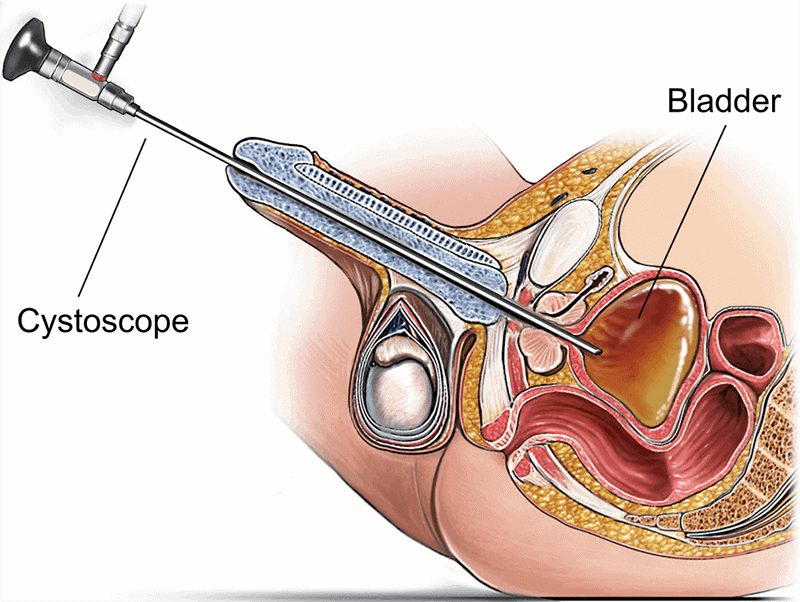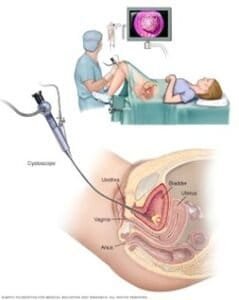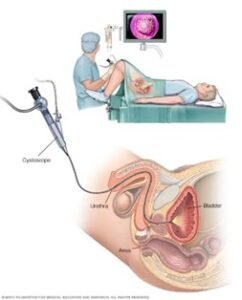Diagnostic Cystoscopy
What is Diagnostic Cystoscopy
Diagnostic cystoscopy is a minimally invasive procedure that involves gently inserting a cystoscope into your urethra and your bladder. This gives us a clear view of the inside of these areas on a screen.
Using a thin, flexible tube called a cystoscope, we can examine your bladder and urethra (the tube that carries urine out of your body) and even treat certain conditions during the same procedure.
If we notice anything that needs attention, we can often treat it right away by passing small surgical instruments through the cystoscope.
It’s a convenient way for us to get a comprehensive look at your urinary system and address any issues we find.

The Importance of Diagnostic Cystoscopy
Diagnostic cystoscopy plays a vital role in urological care because it allows us to see what’s happening inside your body with our own eyes. Sometimes, imaging tests alone aren’t enough to diagnose certain conditions.
With that direct view, we can identify and address issues that might otherwise be missed and because we can pass instruments through the cystoscope, we can often treat issues right away, saving you from needing additional procedures.
What can Cystoscopy diagnose?
Cystoscopy can diagnose:
- Bladder cancer
- Bladder stones
- Bladder inflammation
- Urinary tract infections (UTIs)
- Structural abnormalities
- Blood in the urine (hematuria)
- Recurrent urinary incontinence
How does Cystoscopy work?
By giving us a clear view of your bladder and urethra, diagnostic cystoscopy helps us create an effective treatment plan tailored just for you.
We can identify the exact cause of any urinary symptoms you might be experiencing, so we can provide more targeted and effective treatment.
This direct visualization ensures that any interventions we recommend are as accurate and beneficial as possible.
What should I expect during Cystoscopy?
We understand that medical procedures can be a bit daunting, so we’ll guide you through each step of preparation to help you feel informed and comfortable. Our goal is to make the process as smooth as possible for you.
Before the Procedure: Steps to Take
Before your diagnostic cystoscopy, we’ll have a thorough discussion about your medical history and any medications you’re currently taking.
Preparing for Sedation or Anesthesia
Rarely sedation or anesthesia may be required. If sedation or anaesthesia is part of your cystoscopy, we’ll provide detailed instructions on how to prepare. This might include having someone available to drive you home afterwards, as the effects of sedation or anaesthesia can linger for a while.
We want to make sure you’re fully prepared and know what to expect.
What to Bring on the Day
On the day of your procedure, be sure to bring any relevant medical records, a list of your current medications, and your insurance information.
You should also wear comfortable clothing that you can relax in before and after the cystoscopy.
What happens during Cystoscopy?
First, we’ll make sure you’re as comfortable as possible by providing appropriate anaesthesia or numbing medication. Then, we’ll gently insert the cystoscope (a thin, flexible camera) through your urethra and into your bladder.
This gives us a detailed view of your bladder lining and allows us to diagnose issues like bladder diseases, tumours, or stones.
We can also use the cystoscope to evaluate the tubes that carry urine from your kidneys to your bladder and identify conditions like overactive bladder, narrowing of the urethra, or complications from an enlarged prostate (in men).
For Females: What to Expect
For our female patients, the cystoscopy process is generally quicker since the urethra is shorter. This procedure is especially helpful for diagnosing recurrent urinary tract infections, bladder inflammation, or other conditions that specifically affect women.
It’s a relatively non-invasive process, and most women can resume normal activities shortly after the procedure with minimal recovery time.

Source: Mayo Clinic
For Males: Understanding the Differences
For our male patients, the cystoscopy process takes a bit longer due to the longer urethra and the need to pass the cystoscope through the prostate gland.
This is especially important for diagnosing issues like an enlarged prostate or identifying potential causes of blood in the urine, which can sometimes indicate more serious conditions.
The cystoscope’s journey through the male urinary tract provides valuable insights into overall urological health, including the detection of bladder stones or tumours, and can help us evaluate the cause of symptoms like difficulty urinating.

Source: Mayo Clinic
How Long Does the Procedure Take?
The diagnostic cystoscopy procedure should take no more than five to thirty minutes,with or without sedation or anaesthesia. However, if you’re having a biopsy or treatment, it may be longer.
Immediate Aftercare: Post-Procedure Instructions
After your cystoscopy, we’ll provide specific aftercare instructions to ensure a smooth recovery. We’ll encourage you to drink plenty of water to help flush out any remaining blood in your urine, which is common after this procedure.
You might also experience a mild burning sensation when you urinate, but this should subside within a day or two. If we prescribe antibiotics, be sure to take the full course to prevent infections.
Resting and avoiding strenuous activities for at least 24 hours after the procedure is also recommended.
After the Diagnostic Cystoscopy
Once your diagnostic cystoscopy is complete, we’ll carefully interpret the results and discuss them with you in detail.
Our goal is to help you understand the state of your urinary health and what the next steps in your care plan might be.
During your follow-up appointment, we’ll go over the outcomes of your cystoscopy and explain what they mean for your specific situation.
If we identify any areas of concern, we’ll discuss potential treatment options or the need for further testing.
We want to ensure you clearly understand your condition and feel empowered to make informed decisions about your care in the future.
Follow-Up Care and Additional Testing
Based on the results of your cystoscopy, we may recommend follow-up care or additional testing to further evaluate or manage your condition.
This could involve repeating the cystoscopy at a later date, undergoing imaging tests, or starting a specific treatment plan.
We’ll work closely with you to determine the best course of action tailored to your unique needs and health goals.
Take the Next Step: Book Your Consultation Today
If you’re experiencing urinary symptoms or have concerns about your urological health, we encourage you to book a consultation with our clinic. You can do so directly on this site.
Our team of experienced urologists will carefully evaluate your situation and determine if diagnostic cystoscopy is the right approach for you. Don’t hesitate to reach out – we’re here to support you on your journey to better urinary health and overall well-being.


